Socket programming-tutorial-sk
- 1. Socket Programming Jignesh Patel Palanivel Rathinam connecting processes
- 2. Overview • Introduction to Sockets • A generic Client-Server application • Programming Client-Server in C • Programming Client-Server in Java • References
- 4. Introduction to Sockets • Why Sockets? – Used for Interprocess communication. • The Client-Server model – Most interprocess communication uses client-server model – Client & Server are two processes that wants to communicate with each other – The Client process connects to the Server process, to make a request for information/services own by the Server. – Once the connection is established between Client process and Server process, they can start sending / receiving information. • What are Sockets? – End-point of interprocess communication. – An interface through which processes can send / receive information Socket
- 5. Introduction to Sockets • What exactly creates a Socket? – <IP address, Port #> tuple • What makes a connection? – {Source<IP address, Port #> , Destination <IP address, Port #>} i.e. source socket – destination socket pair uniquely identifies a connection. • Example Server Client Client 192.168.0.1 192.168.0.2 192.168.0.2 80 1343 5488 Client 192.168.0.3 1343
- 6. Introduction to Sockets • Socket Types – STREAM – uses TCP which is reliable, stream oriented protocol – DATAGRAM – uses UDP which is unreliable, message oriented protocol – RAW – provides RAW data transfer directly over IP protocol (no transport layer) • Sockets can use – “unicast” ( for a particular IP address destination) – “multicast” ( a set of destinations – 224.x.x.x) – “broadcast” (direct and limited) – “Loopback” address i.e. 127.x.x.x
- 7. A generic Client-Server application
- 8. A generic TCP application • algorithm for TCP client – Find the IP address and port number of server – Create a TCP socket – Connect the socket to server (Server must be up and listening for new requests) – Send/ receive data with server using the socket – Close the connection • algorithm for TCP server – Find the IP address and port number of server – Create a TCP server socket – Bind the server socket to server IP and Port number (this is the port to which clients will connect) – Accept a new connection from client • returns a client socket that represents the client which is connected – Send/ receive data with client using the client socket – Close the connection with client
- 9. A generic UDP application • algorithm for UDP client – Find the IP address and port number of server – Create a UDP socket – Send/ receive data with server using the socket – Close the connection • algorithm for UDP server – Find the IP address and port number of server – Create a UDP server socket – Bind the server socket to server IP and Port number (this is the port to which clients will send) – Send/ receive data with client using the client socket – Close the connection with client
- 11. Programming Client-Server in C • The steps involved in establishing a socket on the client side are as follows: – Create a socket with the socket() system call – Connect the socket to the address of the server using the connect() system call – Send and receive data using send() and recv() system calls. • The steps involved in establishing a socket on the server side are as follows: – Create a socket with the socket() system call – Bind the socket to an address using the bind() system call. For a server socket on the Internet, an address consists of a port number on the host machine. – Listen for connections with the listen() system call – Accept a connection with the accept() system call. This call typically blocks until a client connects with the server. – Send and receive data
- 12. Programming TCP Client in C #include <stdio.h> #include <sys/types.h> #include <sys/socket.h> #include <netinet/in.h> #include <netdb.h> void error(char *msg){ perror(msg); exit(0);} int main(int argc, char *argv[]){ int sockfd, portno, n; struct sockaddr_in serv_addr; struct hostent *server; char buffer[256]; if (argc < 3) { fprintf(stderr,"usage %s hostname portn", argv[0]); exit(0); } portno = atoi(argv[2]); sockfd = socket(AF_INET, SOCK_STREAM, IPPROTO_TCP); if (sockfd < 0) error("ERROR opening socket"); /* a structure to contain an internet address defined in the include file <netinet/in.h> */ struct sockaddr_in { short sin_family; /* should be AF_INET */ u_short sin_port; struct in_addr sin_addr; char sin_zero[8]; /* not used, must be zero */ }; struct in_addr { unsigned long s_addr; }; Client.c
- 13. Programming TCP Client in C #include <stdio.h> #include <sys/types.h> #include <sys/socket.h> #include <netinet/in.h> #include <netdb.h> void error(char *msg){ perror(msg); exit(0);} int main(int argc, char *argv[]){ int sockfd, portno, n; struct sockaddr_in serv_addr; struct hostent *server; char buffer[256]; if (argc < 3) { fprintf(stderr,"usage %s hostname portn", argv[0]); exit(0); } portno = atoi(argv[2]); sockfd = socket(AF_INET, SOCK_STREAM, IPPROTO_TCP); if (sockfd < 0) error("ERROR opening socket"); Client.c Socket System Call – create an end point for communication #include <sys/types.h> #include <sys/socket.h> int socket(int domain, int type, int protocol); Returns a descriptor domain: selects protocol family e.g. PF_IPX, PF_X25, PF_APPLETALK type: specifies communication semantics e.g. SOCK_DGRAM, SOCK_RAW protocol: specifies a particular protocol to be used e.g. IPPROTO_UDP, IPPROTO_ICMP
- 14. Programming TCP Client in C server = gethostbyname(argv[1]); if (server == NULL) { fprintf(stderr,"ERROR, no such hostn"); exit(0); } bzero((char *) &serv_addr, sizeof(serv_addr)); serv_addr.sin_family = AF_INET; bcopy((char *)server->h_addr, (char *)&serv_addr.sin_addr.s_addr , server->h_length); serv_addr.sin_port = htons(portno); if (connect(sockfd,&serv_addr,sizeof(serv_addr)) < 0) error("ERROR connecting"); printf("Please enter the message: "); bzero(buffer,256); fgets(buffer,255,stdin); n = send(sockfd,buffer,strlen(buffer),0); if (n < 0) error("ERROR writing to socket"); bzero(buffer,256); n = recv(sockfd,buffer,255,0); if (n < 0) error("ERROR reading from socket"); printf("%sn",buffer); close(sockfd); return 0; } Client.c Connect System Call – initiates a connection on a socket #include <sys/types.h> #include <sys/socket.h> int connect( int sockfd, const struct sockaddr *serv_addr, socklen_t addrlen); Returns 0 on success sockfd: descriptor that must refer to a socket serv_addr: address to which we want to connect addrlen: length of serv_addr
- 15. Programming TCP Client in C server = gethostbyname(argv[1]); if (server == NULL) { fprintf(stderr,"ERROR, no such hostn"); exit(0); } bzero((char *) &serv_addr, sizeof(serv_addr)); serv_addr.sin_family = AF_INET; bcopy((char *)server->h_addr, (char *)&serv_addr.sin_addr.s_addr , server->h_length); serv_addr.sin_port = htons(portno); if (connect(sockfd,&serv_addr,sizeof(serv_addr)) < 0) error("ERROR connecting"); printf("Please enter the message: "); bzero(buffer,256); fgets(buffer,255,stdin); n = send(sockfd,buffer,strlen(buffer),0); if (n < 0) error("ERROR writing to socket"); bzero(buffer,256); n = recv(sockfd,buffer,255,0); if (n < 0) error("ERROR reading from socket"); printf("%sn",buffer); close(sockfd); return 0; } Client.c Send System Call – send a message to a socket #include <sys/types.h> #include <sys/socket.h> int send( int s, const void *msg, size_t len, int flags); Returns number of characters sent on success s: descriptor that must refer to a socket in connected state msg: data that we want to send len: length of data flags: use default 0. MSG_OOB, MSG_DONTWAIT
- 16. Programming TCP Client in C server = gethostbyname(argv[1]); if (server == NULL) { fprintf(stderr,"ERROR, no such hostn"); exit(0); } bzero((char *) &serv_addr, sizeof(serv_addr)); serv_addr.sin_family = AF_INET; bcopy((char *)server->h_addr, (char *)&serv_addr.sin_addr.s_addr , server->h_length); serv_addr.sin_port = htons(portno); if (connect(sockfd,&serv_addr,sizeof(serv_addr)) < 0) error("ERROR connecting"); printf("Please enter the message: "); bzero(buffer,256); fgets(buffer,255,stdin); n = send(sockfd,buffer,strlen(buffer),0); if (n < 0) error("ERROR writing to socket"); bzero(buffer,256); n = recv(sockfd,buffer,255,0); if (n < 0) error("ERROR reading from socket"); printf("%sn",buffer); close(sockfd); return 0; } Client.c Recv System Call – receive a message from a socket #include <sys/types.h> #include <sys/socket.h> int recv( int s, const void *buff, size_t len, int flags); Returns number of bytes received on success s: descriptor that must refer to a socket in connected state buff: data that we want to receive len: length of data flags: use default 0. MSG_OOB, MSG_DONTWAIT
- 17. Programming TCP Client in C server = gethostbyname(argv[1]); if (server == NULL) { fprintf(stderr,"ERROR, no such hostn"); exit(0); } bzero((char *) &serv_addr, sizeof(serv_addr)); serv_addr.sin_family = AF_INET; bcopy((char *)server->h_addr, (char *)&serv_addr.sin_addr.s_addr , server->h_length); serv_addr.sin_port = htons(portno); if (connect(sockfd,&serv_addr,sizeof(serv_addr)) < 0) error("ERROR connecting"); printf("Please enter the message: "); bzero(buffer,256); fgets(buffer,255,stdin); n = send(sockfd,buffer,strlen(buffer),0); if (n < 0) error("ERROR writing to socket"); bzero(buffer,256); n = recv(sockfd,buffer,255,0); if (n < 0) error("ERROR reading from socket"); printf("%sn",buffer); close(sockfd); return 0; } Client.c Close System Call – close a socket descriptor #include <unistd.h> int close( int s); Returns 0 on success s: descriptor to be closed
- 18. Programming TCP Server in C #include <stdio.h> #include <sys/types.h> #include <sys/socket.h> #include <netinet/in.h> void error(char *msg){ perror(msg); exit(0);} int main(int argc, char *argv[]){ int sockfd, newsockfd, portno, clilen; char buffer[256]; struct sockaddr_in serv_addr, cli_addr; int n; if (argc < 2) { fprintf(stderr,"ERROR, no port providedn"); exit(1); } sockfd = socket(AF_INET, SOCK_STREAM, 0); if (sockfd < 0) error("ERROR opening socket"); bzero((char *) &serv_addr, sizeof(serv_addr)); portno = atoi(argv[1]); serv_addr.sin_family = AF_INET; serv_addr.sin_addr.s_addr = INADDR_ANY; serv_addr.sin_port = htons(portno); Server.c
- 19. Programming TCP Server in C if (bind(sockfd, (struct sockaddr *) &serv_addr, sizeof(serv_addr)) < 0) error("ERROR on binding"); listen(sockfd,5); clilen = sizeof(cli_addr); newsockfd = accept(sockfd, (struct sockaddr *) &cli_addr, &clilen); if (newsockfd < 0) error("ERROR on accept"); bzero(buffer,256); n = recv(newsockfd,buffer,255,0); if (n < 0) error("ERROR reading from socket"); printf("Here is the message: %sn",buffer); n = send(newsockfd,"I got your message",18,0); if (n < 0) error("ERROR writing to socket"); close(newsockfd); close(sockfd); return 0; } Server.c Bind System Call – bind a name to a socket #include <sys/types.h> #include <sys/socket.h> int bind( int sockfd, const struct sockaddr *serv_addr, socklen_t addrlen); Returns 0 on success sockfd: descriptor that must refer to a socket serv_addr: address to which we want to connect addrlen: length of serv_addr
- 20. Programming TCP Server in C if (bind(sockfd, (struct sockaddr *) &serv_addr, sizeof(serv_addr)) < 0) error("ERROR on binding"); listen(sockfd,5); clilen = sizeof(cli_addr); newsockfd = accept(sockfd, (struct sockaddr *) &cli_addr, &clilen); if (newsockfd < 0) error("ERROR on accept"); bzero(buffer,256); n = recv(newsockfd,buffer,255,0); if (n < 0) error("ERROR reading from socket"); printf("Here is the message: %sn",buffer); n = send(newsockfd,"I got your message",18,0); if (n < 0) error("ERROR writing to socket"); close(newsockfd); close(sockfd); return 0; } Server.c Listen System Call – listen for connections on a socket #include <sys/types.h> #include <sys/socket.h> int listen( int s, int backlog); Returns 0 on success s: descriptor that must refer to a socket backlog: maximum length the queue for completely established sockets waiting to be accepted addrlen: length of serv_addr
- 21. Programming TCP Server in C if (bind(sockfd, (struct sockaddr *) &serv_addr, sizeof(serv_addr)) < 0) error("ERROR on binding"); listen(sockfd,5); clilen = sizeof(cli_addr); newsockfd = accept(sockfd, (struct sockaddr *) &cli_addr, &clilen); if (newsockfd < 0) error("ERROR on accept"); bzero(buffer,256); n = recv(newsockfd,buffer,255,0); if (n < 0) error("ERROR reading from socket"); printf("Here is the message: %sn",buffer); n = send(newsockfd,"I got your message",18,0); if (n < 0) error("ERROR writing to socket"); close(newsockfd); close(sockfd); return 0; } Server.c Accept System Call – accepts a connection on a socket #include <sys/types.h> #include <sys/socket.h> int accept( int sockfd, const struct sockaddr *addr, socklen_t addrlen); Returns a non-negative descriptor on success sockfd: descriptor that must refer to a socket addr: filled with address of connecting entity addrlen: length of addr
- 22. Programming UDP Client in C • The client code for a datagram socket client is the same as that for a stream socket with the following differences. – the socket system call has SOCK_DGRAM instead of SOCK_STREAM as its second argument & IPPROTO_UDP instead of IPPROTO_TCP as its third argument. – there is no connect() system call – instead of send() and recv(), the client uses sendto() and recvfrom() sock = socket(AF_INET, SOCK_DGRAM, IPPROTO_UDP); len = sizeof(struct sockaddr_in); while (1) { /* write */ n = sendto(sock,“Got your messagen",17, 0,(struct sockaddr *) &server, len); f (n < 0) error("sendto"); /* read */ n = recvfrom(sock,buf,1024,0,(struct sockaddr *)&from, len); if (n < 0) error("recvfrom"); }
- 23. Programming UDP Server in C sock = socket(AF_INET, SOCK_DGRAM, IPPROTO_UDP); len = sizeof(struct sockaddr_in); while (1) { /* read */ n = recvfrom(sock,buf,1024,0,(struct sockaddr *)&from, len); if (n < 0) error("recvfrom"); /* write */ n = sendto(sock,"Got your messagen",17, 0,(struct sockaddr *)&from, len); f (n < 0) error("sendto"); } • Server code with a datagram socket is similar to the stream socket code with following differences. – Servers using datagram sockets do not use the listen() or the accept() system calls. – After a socket has been bound to an address, the program calls recvfrom() to read a message or sendto() to send a message.
- 24. Programming Client-Server in C #include <winsock.h> ….. void main(int argc,char *argv[]){ WSADATA wsda; // if this doesn’t work // WSAData wsda; // then try this WSAStartup(0x0101,&wsda); ….. WSACleanup(); closesocket(sockfd); } • In case of Windows Everything in the code is same as described previously except the following differences – You have to tell your compiler to link in the Winsock library, usually called wsock32.lib or winsock32.lib – On Visual C++, this can be done through the Project menu, under Settings.... Click the Link tab, and look for the box titled "Object/library modules". Add "wsock32.lib" to that list. – On Visual Studio .NET, add “wsock32.lib” under Project menu, Properties -> Linker -> Input -> Additional Dependencies
- 25. Programming Client-Server in Java
- 26. Programming TCP Client-Server in Java • All the classes related to sockets are in the java.net package, so make sure to import that package when you program sockets. • All the input/output stream classes are in the java.io package, include this also • How to open a socket? – If you are programming a client, then you would create an object of Socket class – Machine name is the machine you are trying to open a connection to, – PortNumber is the port (a number) on which the server you are trying to connect to is running. select one that is greater than 1,023! Why?? Socket MyClient; try { MyClient = new Socket("Machine name", PortNumber); } catch (IOException e) { System.out.println(e); }
- 27. Programming TCP Client-Server in Java • If you are programming a server, then this is how you open a socket: • When implementing a server you also need to create a socket object from the ServerSocket in order to listen for and accept connections from clients. ServerSocket MyService; try { MyServerice = new ServerSocket(PortNumber); } catch (IOException e) { System.out.println(e); } Socket clientSocket = null; try { clientSocket = MyService.accept(); } catch (IOException e) { System.out.println(e); }
- 28. Programming TCP Client-Server in Java • How to create an input stream? – On the client side, you can use the DataInputStream class to create an input stream to receive response from the server: – The class DataInputStream allows you to read lines of text and Java primitive data types in a portable way. It has methods such as read, readChar, readInt, readDouble, and readLine,. – On the server side, you can use DataInputStream to receive input from the client: DataInputStream input; try { input = new DataInputStream(MyClient.getInputStream()); } catch (IOException e) { System.out.println(e); } DataInputStream input; try { input = new DataInputStream(clientSocket.getInputStream()); } catch (IOException e) { System.out.println(e); }
- 29. Programming TCP Client-Server in Java • How to create an output stream? – On the client side, you can create an output stream to send information to the server socket using the class PrintStream or DataOutputStream of java.io: – The class PrintStream has methods for displaying textual representation of Java primitive data types. Its write and println methods are important. Also, you may want to use the DataOutputStream: PrintStream output; try { output = new PrintStream(MyClient.getOutputStream()); } catch (IOException e) { System.out.println(e); } DataOutputStream output; try { output = new DataOutputStream(MyClient.getOutputStream()); } catch (IOException e) { System.out.println(e); }
- 30. Programming TCP Client-Server in Java • On the server side – you can use the class PrintStream to send information to the client. • Note: You can use the class DataOutputStream as mentioned previously. PrintStream output; try { output = new PrintStream(clientSocket.getOutputStream()); } catch (IOException e) { System.out.println(e); }
- 31. Programming TCP Client-Server in Java • How to close sockets? – You should always close the output and input stream before you close the socket. – On the client side: – On the server side: try { output.close(); input.close(); MyClient.close(); } catch (IOException e) { System.out.println(e); } try { output.close(); input.close(); clientSocket.close(); MyService.close(); } catch (IOException e) { System.out.println(e); }
- 32. Programming UDP Client-Server in Java • How to open a datagram socket? – If you are programming a client, then you would create an object of DatagramSocket class • If you are programming a server, then this is how you open a socket: try { DatagramSocket socket = new DatagramSocket(); } catch (IOException e) { System.out.println(e); } DatagramSocket socket = null; try { socket = new DatagramSocket(4445); } catch (IOException e) { System.out.println(e); }
- 33. Programming UDP Client-Server in Java • How to send/receive on Datagram sockets? – On the client side, you can use the DatagramPacket class – To send data – To receive data byte[] buf = new byte[256]; InetAddress address = InetAddress.getByName(args[0]); DatagramPacket packet = new DatagramPacket(buf, buf.length, address, 4445); socket.send(packet); packet = new DatagramPacket(buf, buf.length); socket.receive(packet); String received = new String(packet.getData()); System.out.println(“Received from server: " + received);
- 34. Programming UDP Client-Server in Java • How to send/receive on Datagram sockets? – On the Server side, you can use the DatagramPacket class – To receive data • To send data • How to close a Datagram socket? byte[] buf = new byte[256]; DatagramPacket packet = new DatagramPacket(buf, buf.length); socket.receive(packet); InetAddress address = packet.getAddress(); int port = packet.getPort(); packet = new DatagramPacket(buf, buf.length, address, port); socket.send(packet); socket.close();
- 35. References • Man pages in Linux Accesssible through following command – man 2 <system_call_name> – E.g. man 2 socket • “Unix network programming” by Richard Stevens • Beej’s guide to Network Programming http://beej.us/guide/bgnet/ • The Java Tutorial – Custom Networking http://java.sun.com/docs/books/tutorial/networking/ • Lecture notes of cs423 from Dr. Bob Cotter http://www.sce.umkc.edu/~cotterr/cs423_fs05/cs423_fs05_lectures.html




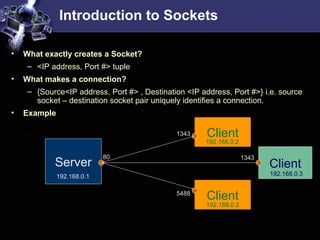
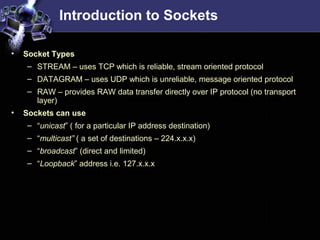
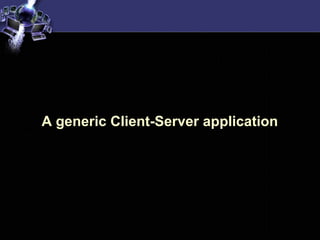
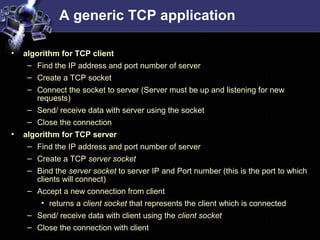
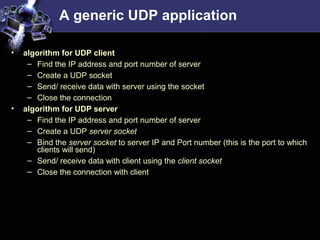


![Programming TCP Client in C
#include <stdio.h>
#include <sys/types.h>
#include <sys/socket.h>
#include <netinet/in.h>
#include <netdb.h>
void error(char *msg){ perror(msg); exit(0);}
int main(int argc, char *argv[]){
int sockfd, portno, n;
struct sockaddr_in serv_addr;
struct hostent *server;
char buffer[256];
if (argc < 3) {
fprintf(stderr,"usage %s hostname portn", argv[0]);
exit(0);
}
portno = atoi(argv[2]);
sockfd = socket(AF_INET, SOCK_STREAM, IPPROTO_TCP);
if (sockfd < 0) error("ERROR opening socket");
/* a structure to contain an internet address
defined in the include file <netinet/in.h> */
struct sockaddr_in {
short sin_family; /* should be AF_INET */
u_short sin_port;
struct in_addr sin_addr;
char sin_zero[8]; /* not used, must be zero
*/
};
struct in_addr {
unsigned long s_addr;
};
Client.c](https://image.slidesharecdn.com/socket-programming-tutorial-sk-141218234146-conversion-gate01/85/Socket-programming-tutorial-sk-12-320.jpg)
![Programming TCP Client in C
#include <stdio.h>
#include <sys/types.h>
#include <sys/socket.h>
#include <netinet/in.h>
#include <netdb.h>
void error(char *msg){ perror(msg); exit(0);}
int main(int argc, char *argv[]){
int sockfd, portno, n;
struct sockaddr_in serv_addr;
struct hostent *server;
char buffer[256];
if (argc < 3) {
fprintf(stderr,"usage %s hostname portn", argv[0]);
exit(0);
}
portno = atoi(argv[2]);
sockfd = socket(AF_INET, SOCK_STREAM, IPPROTO_TCP);
if (sockfd < 0) error("ERROR opening socket");
Client.c Socket System Call – create an end point for
communication
#include <sys/types.h>
#include <sys/socket.h>
int socket(int domain, int type, int protocol);
Returns a descriptor
domain: selects protocol family
e.g. PF_IPX, PF_X25, PF_APPLETALK
type: specifies communication semantics
e.g. SOCK_DGRAM, SOCK_RAW
protocol: specifies a particular protocol to be used
e.g. IPPROTO_UDP, IPPROTO_ICMP](https://image.slidesharecdn.com/socket-programming-tutorial-sk-141218234146-conversion-gate01/85/Socket-programming-tutorial-sk-13-320.jpg)
![Programming TCP Client in C
server = gethostbyname(argv[1]);
if (server == NULL) { fprintf(stderr,"ERROR, no such hostn"); exit(0); }
bzero((char *) &serv_addr, sizeof(serv_addr));
serv_addr.sin_family = AF_INET;
bcopy((char *)server->h_addr, (char *)&serv_addr.sin_addr.s_addr
, server->h_length);
serv_addr.sin_port = htons(portno);
if (connect(sockfd,&serv_addr,sizeof(serv_addr)) < 0)
error("ERROR connecting");
printf("Please enter the message: ");
bzero(buffer,256); fgets(buffer,255,stdin);
n = send(sockfd,buffer,strlen(buffer),0);
if (n < 0) error("ERROR writing to socket");
bzero(buffer,256);
n = recv(sockfd,buffer,255,0);
if (n < 0)
error("ERROR reading from socket");
printf("%sn",buffer);
close(sockfd);
return 0;
}
Client.c
Connect System Call – initiates a connection on
a socket
#include <sys/types.h>
#include <sys/socket.h>
int connect( int sockfd,
const struct sockaddr *serv_addr,
socklen_t addrlen);
Returns 0 on success
sockfd: descriptor that must refer to a socket
serv_addr: address to which we want to connect
addrlen: length of serv_addr](https://image.slidesharecdn.com/socket-programming-tutorial-sk-141218234146-conversion-gate01/85/Socket-programming-tutorial-sk-14-320.jpg)
![Programming TCP Client in C
server = gethostbyname(argv[1]);
if (server == NULL) { fprintf(stderr,"ERROR, no such hostn"); exit(0); }
bzero((char *) &serv_addr, sizeof(serv_addr));
serv_addr.sin_family = AF_INET;
bcopy((char *)server->h_addr, (char *)&serv_addr.sin_addr.s_addr
, server->h_length);
serv_addr.sin_port = htons(portno);
if (connect(sockfd,&serv_addr,sizeof(serv_addr)) < 0)
error("ERROR connecting");
printf("Please enter the message: ");
bzero(buffer,256); fgets(buffer,255,stdin);
n = send(sockfd,buffer,strlen(buffer),0);
if (n < 0) error("ERROR writing to socket");
bzero(buffer,256);
n = recv(sockfd,buffer,255,0);
if (n < 0)
error("ERROR reading from socket");
printf("%sn",buffer);
close(sockfd);
return 0;
}
Client.c
Send System Call – send a message to a
socket
#include <sys/types.h>
#include <sys/socket.h>
int send( int s, const void *msg, size_t len,
int flags);
Returns number of characters sent on success
s: descriptor that must refer to a socket in
connected state
msg: data that we want to send
len: length of data
flags: use default 0. MSG_OOB, MSG_DONTWAIT](https://image.slidesharecdn.com/socket-programming-tutorial-sk-141218234146-conversion-gate01/85/Socket-programming-tutorial-sk-15-320.jpg)
![Programming TCP Client in C
server = gethostbyname(argv[1]);
if (server == NULL) { fprintf(stderr,"ERROR, no such hostn"); exit(0); }
bzero((char *) &serv_addr, sizeof(serv_addr));
serv_addr.sin_family = AF_INET;
bcopy((char *)server->h_addr, (char *)&serv_addr.sin_addr.s_addr
, server->h_length);
serv_addr.sin_port = htons(portno);
if (connect(sockfd,&serv_addr,sizeof(serv_addr)) < 0)
error("ERROR connecting");
printf("Please enter the message: ");
bzero(buffer,256); fgets(buffer,255,stdin);
n = send(sockfd,buffer,strlen(buffer),0);
if (n < 0) error("ERROR writing to socket");
bzero(buffer,256);
n = recv(sockfd,buffer,255,0);
if (n < 0)
error("ERROR reading from socket");
printf("%sn",buffer);
close(sockfd);
return 0;
}
Client.c
Recv System Call – receive a message from a
socket
#include <sys/types.h>
#include <sys/socket.h>
int recv( int s, const void *buff, size_t len,
int flags);
Returns number of bytes received on success
s: descriptor that must refer to a socket in
connected state
buff: data that we want to receive
len: length of data
flags: use default 0. MSG_OOB, MSG_DONTWAIT](https://image.slidesharecdn.com/socket-programming-tutorial-sk-141218234146-conversion-gate01/85/Socket-programming-tutorial-sk-16-320.jpg)
![Programming TCP Client in C
server = gethostbyname(argv[1]);
if (server == NULL) { fprintf(stderr,"ERROR, no such hostn"); exit(0); }
bzero((char *) &serv_addr, sizeof(serv_addr));
serv_addr.sin_family = AF_INET;
bcopy((char *)server->h_addr, (char *)&serv_addr.sin_addr.s_addr
, server->h_length);
serv_addr.sin_port = htons(portno);
if (connect(sockfd,&serv_addr,sizeof(serv_addr)) < 0)
error("ERROR connecting");
printf("Please enter the message: ");
bzero(buffer,256); fgets(buffer,255,stdin);
n = send(sockfd,buffer,strlen(buffer),0);
if (n < 0) error("ERROR writing to socket");
bzero(buffer,256);
n = recv(sockfd,buffer,255,0);
if (n < 0)
error("ERROR reading from socket");
printf("%sn",buffer);
close(sockfd);
return 0;
}
Client.c
Close System Call – close a socket descriptor
#include <unistd.h>
int close( int s);
Returns 0 on success
s: descriptor to be closed](https://image.slidesharecdn.com/socket-programming-tutorial-sk-141218234146-conversion-gate01/85/Socket-programming-tutorial-sk-17-320.jpg)
![Programming TCP Server in C
#include <stdio.h>
#include <sys/types.h>
#include <sys/socket.h>
#include <netinet/in.h>
void error(char *msg){ perror(msg); exit(0);}
int main(int argc, char *argv[]){
int sockfd, newsockfd, portno, clilen;
char buffer[256];
struct sockaddr_in serv_addr, cli_addr;
int n;
if (argc < 2) { fprintf(stderr,"ERROR, no port providedn"); exit(1); }
sockfd = socket(AF_INET, SOCK_STREAM, 0);
if (sockfd < 0) error("ERROR opening socket");
bzero((char *) &serv_addr, sizeof(serv_addr));
portno = atoi(argv[1]);
serv_addr.sin_family = AF_INET;
serv_addr.sin_addr.s_addr = INADDR_ANY;
serv_addr.sin_port = htons(portno);
Server.c](https://image.slidesharecdn.com/socket-programming-tutorial-sk-141218234146-conversion-gate01/85/Socket-programming-tutorial-sk-18-320.jpg)
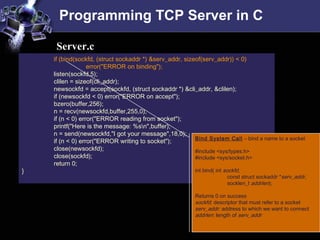

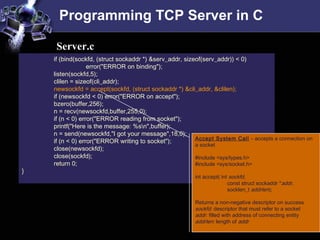
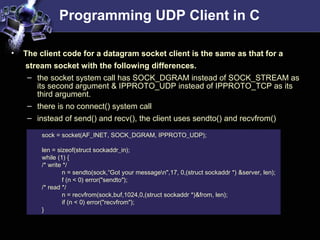

![Programming Client-Server in C
#include <winsock.h>
…..
void main(int argc,char *argv[]){
WSADATA wsda; // if this doesn’t work
// WSAData wsda; // then try this
WSAStartup(0x0101,&wsda);
…..
WSACleanup();
closesocket(sockfd);
}
• In case of Windows Everything in the code is same as described
previously except the following differences
– You have to tell your compiler to link in the Winsock library, usually
called wsock32.lib or winsock32.lib
– On Visual C++, this can be done through the Project menu, under
Settings.... Click the Link tab, and look for the box titled "Object/library
modules". Add "wsock32.lib" to that list.
– On Visual Studio .NET, add “wsock32.lib” under Project menu, Properties
-> Linker -> Input -> Additional Dependencies](https://image.slidesharecdn.com/socket-programming-tutorial-sk-141218234146-conversion-gate01/85/Socket-programming-tutorial-sk-24-320.jpg)

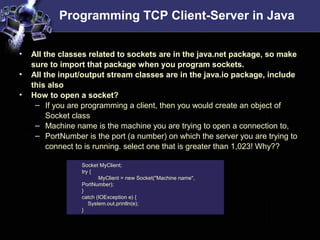
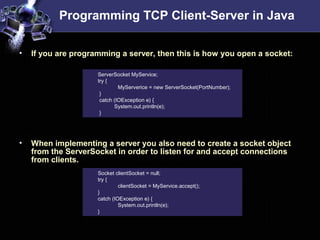




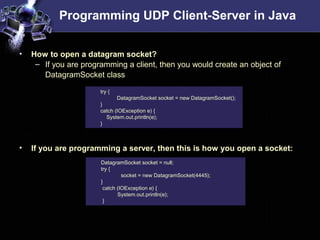
![Programming UDP Client-Server in Java
• How to send/receive on Datagram sockets?
– On the client side, you can use the DatagramPacket class
– To send data
– To receive data
byte[] buf = new byte[256];
InetAddress address = InetAddress.getByName(args[0]);
DatagramPacket packet = new DatagramPacket(buf,
buf.length, address, 4445);
socket.send(packet);
packet = new DatagramPacket(buf, buf.length);
socket.receive(packet);
String received = new String(packet.getData());
System.out.println(“Received from server: " + received);](https://image.slidesharecdn.com/socket-programming-tutorial-sk-141218234146-conversion-gate01/85/Socket-programming-tutorial-sk-33-320.jpg)
![Programming UDP Client-Server in Java
• How to send/receive on Datagram sockets?
– On the Server side, you can use the DatagramPacket class
– To receive data
• To send data
• How to close a Datagram socket?
byte[] buf = new byte[256];
DatagramPacket packet = new DatagramPacket(buf,
buf.length);
socket.receive(packet);
InetAddress address = packet.getAddress();
int port = packet.getPort();
packet = new DatagramPacket(buf, buf.length, address, port);
socket.send(packet);
socket.close();](https://image.slidesharecdn.com/socket-programming-tutorial-sk-141218234146-conversion-gate01/85/Socket-programming-tutorial-sk-34-320.jpg)
